Addition Chapter Notes | Mathematics Class 2 ICSE PDF Download
Introduction
Addition is like putting things together to find out how many you have in total! Imagine you have some toys, and your friend gives you a few more. By adding them, you can count all the toys you have now. This chapter will teach you fun and easy ways to add numbers, from simple facts to adding bigger numbers step by step. Let’s dive into the world of addition and make it exciting!
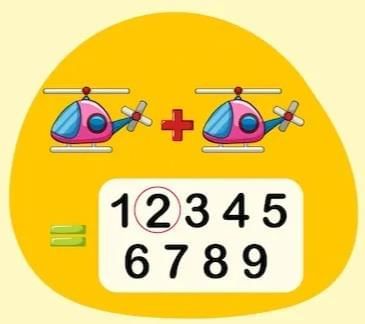
Addition Facts
- Addition means combining two numbers to get a total.
- You can add numbers in any order, and the answer stays the same.
- Adding zero to any number doesn’t change the number.
Example:
2 + 5 = 7,

and 5 + 2 = 7

Also, 6 + 0 = 6, and 0 + 6 = 6.
Addition through Pattern
- Adding numbers in different patterns gives the same sum.
- Changing the order of numbers does not change the total.
Example: 26 + 40 = 66, and 40 + 26 = 66.
Addition of Two 2-Digit Numbers
- Step 1: Write the numbers vertically, aligning tens and ones.
- Step 2: Add the ones digits first.
- Step 3: Add the tens digits next.
- Step 4: Combine the results to get the total sum.
Example: To add 42 + 36:
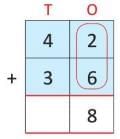
- Add ones: 2 + 6 = 8.
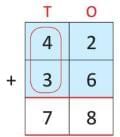
- Add tens: 4 + 3 = 7.
- So, 42 + 36 = 78.
Addition of Three 2-Digit Numbers
- Step 1: Write the three numbers vertically, aligning tens and ones.
- Step 2: Add the ones of the first two numbers, then add the ones of the third number to the result.
- Step 3: Add the tens of the first two numbers, then add the tens of the third number to the result.
- Step 4: Combine the results to get the total sum.
Example: To add 23 + 12 + 43:
- Write:
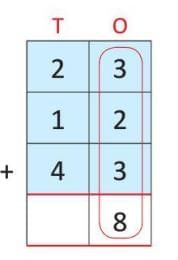
- Add ones: 3 + 2 = 5, then 5 + 3 = 8.
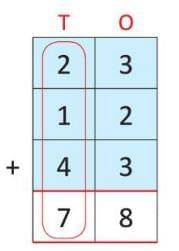
- Add tens: 2 + 1 = 3, then 3 + 4 = 7.
- So, 23 + 12 + 43 = 78.
Addition Using Carry Over Method
- Step 1: Write the numbers vertically, aligning tens and ones.
- Step 2: Add the ones digits.
- Step 3: If the ones sum is 10 or more, write the ones digit and carry over the tens digit to the tens column.
- Step 4: Add the tens digits, including the carried-over number.
- Step 5: Combine the results to get the total sum.
Example: To add 56 + 27:
- Write:
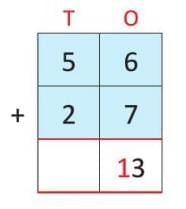
- Add ones: 6 + 7 = 13. Write 3, carry over 1 to tens.
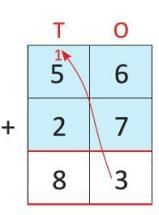
- Add tens: 1 + 5 + 2 = 8.
- So, 56 + 27 = 83.
Addition Using Expanded Form
- Step 1: Write each number in expanded form (tens + ones).
- Step 2: Add the tens of both numbers together.
- Step 3: Add the ones of both numbers together.
- Step 4: Add the results of tens and ones to get the total sum.
Example: To add 56 + 28:
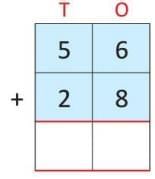
- Write in the expanded form

- Add tens: 50 + 20 = 70.
- Add ones: 6 + 8 = 14.
- Add results: 70 + 14 = 84.
- So, 56 + 28 = 84.
Skip Counting
- Skip counting means counting forward by a fixed number.
- Start from a given number and add the fixed number each time.
- Continue counting by adding the same number repeatedly.
Example: Starting from 121, skip count in 3s:

Word Problems
- Read the problem carefully to understand what is being asked.
- Identify the numbers to be added.
- Write the numbers vertically, aligning tens and ones.
- Add the numbers step by step to find the total.
- Write the answer in a complete sentence.
Example: Chitra has 28 beads. Kritika has 36 beads. How many beads are there in all?
Write:
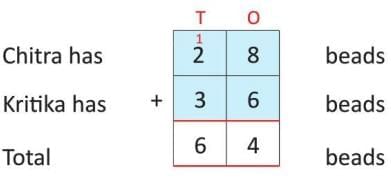
- Add ones: 8 + 6 = 14. Write 4, carry over 1.
- Add tens: 1 + 2 + 3 = 6.
- Answer: There are 64 beads in all.
Framing Word Problems
- Create a story or situation that involves adding two numbers.
- Include the numbers to be added in the story.
- End the story with a question asking for the total.
- Ensure the problem is clear and easy to understand.
Example: For 19 + 35:
- Problem: There are 19 people on the ground floor of a building and 35 people on its first floor. How many people are there in the building?
Mental Addition
Method 1: Breaking Numbers
- Break the numbers into tens and ones.
- Add the tens together, then add the ones.
- Combine the results to get the total sum.
Example: To add 36 + 20:
- Break: 36 = 30 + 6, 20 = 20.
- Add tens: 30 + 20 = 50.
- Add ones: 6.
- Combine: 50 + 6 = 56.
- So, 36 + 20 = 56.
Method 2: Using Easy Numbers
- Choose a number close to the actual number that’s easier to add.
- Add the easy number to get a temporary sum.
- Correct the sum by subtracting the extra amount added.
Example: To add 23 + 47:
- 47 is close to 50 (47 + 3 = 50).
- Add: 23 + 50 = 73.
- Subtract extra 3: 73 - 3 = 70.
- So, 23 + 47 = 70.
|
50 docs|10 tests
|
FAQs on Addition Chapter Notes - Mathematics Class 2 ICSE
| 1. What are addition facts and why are they important for students? |  |
| 2. How can students use patterns to aid in addition? |  |
| 3. What is the carry over method in addition? |  |
| 4. Can you explain how to add three 2-digit numbers effectively? |  |
| 5. How can word problems be framed to help students understand addition better? |  |





















